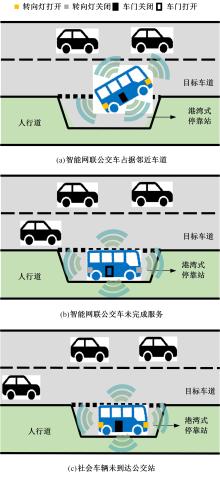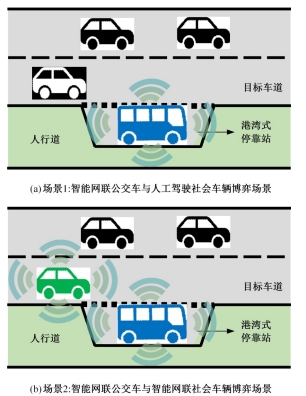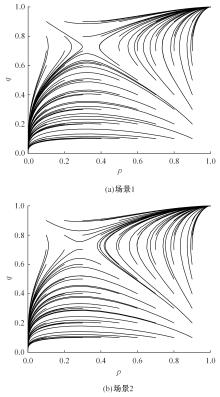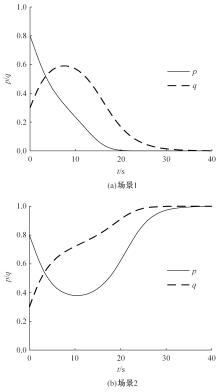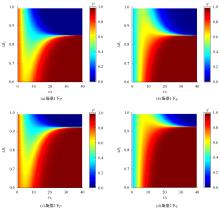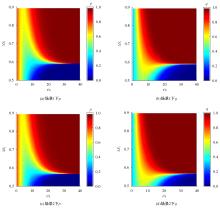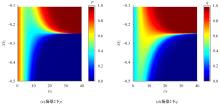Journal of Jilin University(Engineering and Technology Edition) ›› 2024, Vol. 54 ›› Issue (1): 124-135.doi: 10.13229/j.cnki.jdxbgxb.20220207
Evolutionary game mechanism of mandatory lane changing for exiting for intelligent connected bus
- School of Transportation and Logistics,Dalian University of Technology,Dalian 116024,China
CLC Number:
- U121
| 1 | Li M, Li Z, Xu C, et al. Short-term prediction of safety and operation impacts of lane changes in oscillations with empirical vehicle trajectories[J]. Accident Analysis and Prevention, 2020, 135: No.105345. |
| 2 | Kita H. A merging-giveway interaction model of cars in a merging section: a game theoretic analysis[J]. Transportation Research Part A: Policy and Practice, 1999, 33: 305-312. |
| 3 | Arbis D, Dixit V V. Game theoretic model for lane changing: incorporating conflict risks[J]. Accident Analysis and Prevention, 2019, 125(1): 158-164. |
| 4 | 曲大义, 黑凯先, 郭海兵, 等. 车联网环境下车辆换道博弈行为及模型[J]. 吉林大学学报:工学版, 2021, 52(1): 101-109. |
| Qu Da-yi, Kai-xian Hei, Guo Hai-bing, et al. Game behavior and model of lane-changing on the internet of vehicles environment[J]. Journal of Jilin University(Engineering and Technology Edition), 2021, 52(1): 101-109. | |
| 5 | Yao R, Du X, Zhang W, et al. Game model of lane changing for bus exiting at bus bay stops[J]. Journal of Transportation Engineering, Part A: Systems, 2021, 147(9): No.04021046. |
| 6 | Shao H, Wang J, Wang Y, et al. Electric bicycle lane-changing behavior under strategy games[J]. Sustainability, 2018, 10(9): No.3019. |
| 7 | Ali Y, Zheng Z, Haque Md M, et al. A game theory-based approach for modelling mandatory lane-changing behaviour in a connected environment[J]. Transportation Research Part C: Emerging Technologies, 2019, 106: 220-242. |
| 8 | Kang K, Rakha H A. Modeling driver merging behavior: a repeated game theoretical approach[J]. Journal of the Transportation Research Board, 2018, 2672(20): 144-153. |
| 9 | Lin D, Li L, Jabari S E. Pay to change lanes: a cooperative lane-changing strategy for connected/automated driving[J]. Transportation Research Part C: Emerging Technologies, 2019, 105: 550-564. |
| 10 | 李克强, 戴一凡, 李升波, 等. 智能网联汽车(ICV)技术的发展现状及趋势[J]. 汽车安全与节能学报, 2017, 8(1): 1-14. |
| Li Ke-qiang, Dai Yi-fan, Li Sheng-bo, et al. State-of-the-art and technical trends of intelligent and connected vehicles[J]. Journal of Automotive Safety and Energy, 2017, 8(1): 1-14. | |
| 11 | 崔明阳, 黄荷叶, 许庆, 等. 智能网联汽车架构、功能与应用关键技术[J]. 清华大学学报, 2022, 62(3): 493-508. |
| Cui Ming-yang, Huang He-ye, Xu Qing, et al. Survey of intelligent and connected vehicle technologies: architectures, functions and applications[J]. Journal of Tsinghua University(Science and Technology), 2022, 62(3): 493-508. | |
| 12 | Zhai C, Wu W. A macro traffic flow model with headway variation tendency and bounded rationality[J]. Modern Physics Letter B, 2021, 35(2): 2150054. |
| 13 | Yan F, Liu M, Ding C, et al. Driving style recognition based on electroencephalography data from a simulated driving experiment[J]. Frontiers in Psychology, 2019, 10: No.1254. |
| 14 | Huo D, Ma J, Chang R. Lane-changing-decision characteristics and the allocation of visual attention of drivers with an angry driving style[J]. Transportation Research Part F: Traffic Psychology and Behaviour, 2020, 71: 62-75. |
| 15 | Tanimoto J, Futamata M, Tanaka M. Automated vehicle control systems need to solve social dilemmas to be disseminated[J]. Chaos Solitons and Fractals, 2020, 138: No.109861. |
| 16 | Yao R, Du X, Qi W, et al. Evolutionary dynamics of mandatory lane changing for bus exiting[J]. Journal of Advanced Transportation, 2021, 2021: No.2958647. |
| 17 | 中华人民共和国交通运输部综合规划司. 2020年交通运输行业发展统计公报[EB/OL].[2022-02-28]. |
| 18 | Gao J, Chen H, Liu Y, et al. The effect of after-treatment techniques on the correlations between driving behaviours and NO x emissions of passenger cars[J]. Journal of Cleaner Production, 2021, 288: No.125647. |
| [1] | Zhuang-lin MA,Shan-shan CUI,Da-wei HU,Jin WANG. Travel mode choice of traditional car travelers after implementation of driving restriction policy [J]. Journal of Jilin University(Engineering and Technology Edition), 2023, 53(7): 1981-1993. |
| [2] | Ya-li ZHANG,Rui FU,Wei YUAN,Ying-shi GUO. Classification and recognition model of entering and leaving stops' driving style considering energy consumption [J]. Journal of Jilin University(Engineering and Technology Edition), 2023, 53(7): 2029-2042. |
| [3] | Chao-ying YIN,Ying LU,Chun-fu SHAO,Jian-xiao MA,De-jie XU. Impacts of built environment on commuting mode choice considering spatial autocorrelation [J]. Journal of Jilin University(Engineering and Technology Edition), 2023, 53(7): 1994-2000. |
| [4] | Heng-yan PAN,Yong-gang WANG,De-lin LI,Jun-xian CHEN,Jie SONG,Yu-quan YANG. Evaluating and forecasting rear⁃end collision risk of long longitudinal gradient roadway via traffic conflict [J]. Journal of Jilin University(Engineering and Technology Edition), 2023, 53(5): 1355-1363. |
| [5] | Kai LU,Guang-hui XU,Zhi-hong YE,Yong-jie LIN. Algebraic method of bidirectional green wave coordination control for the head of the platoon considering the clearance time [J]. Journal of Jilin University(Engineering and Technology Edition), 2023, 53(2): 421-429. |
| [6] | Qian CAO,Zhi-hui LI,Peng-fei TAO,Yong-jian MA,Chen-xi YANG. Traffic accident risk assessment method for road network considering risk heterogeneity [J]. Journal of Jilin University(Engineering and Technology Edition), 2023, 53(10): 2817-2825. |
| [7] | Xin ZHANG,Wei-hua ZHANG. Safety analysis of main line under different traffic conditions in expressway confluence area [J]. Journal of Jilin University(Engineering and Technology Edition), 2022, 52(6): 1308-1314. |
| [8] | Da-yi QU,Zi-xu ZHAO,Yan-feng JIA,Tao WANG,Qiong-hui LIU. Car⁃following dynamics characteristics and model based on Lennard⁃Jones potential [J]. Journal of Jilin University(Engineering and Technology Edition), 2022, 52(11): 2549-2557. |
| [9] | Chun-jiao DONG,Dai-yue DONG,Cheng-xiang ZHU-GE,Li ZHEN. Trip characteristics and decision⁃making behaviors modeling of electric bicycles riding [J]. Journal of Jilin University(Engineering and Technology Edition), 2022, 52(11): 2618-2625. |
| [10] | Da-yi QU,Kai-xian HEI,Hai-bing GUO,Yan-feng JIA,Tao WANG. Game behavior and model of lane-changing on the internet of vehicles environment [J]. Journal of Jilin University(Engineering and Technology Edition), 2022, 52(1): 101-109. |
| [11] | Wen-hui ZHANG,Jing YI,Wei LIU,Qiu-ying YU,Lian-zhen WANG. Injury mechanism of occupants in bus during rear-end crash based on MADYMO [J]. Journal of Jilin University(Engineering and Technology Edition), 2022, 52(1): 118-126. |
| [12] | Zhi-wei LIU,Jian-rong LIU,Wei DENG. Travelers′ choice behavior of autonomous vehicles based on latent class [J]. Journal of Jilin University(Engineering and Technology Edition), 2021, 51(4): 1261-1268. |
| [13] | Jin XU,Cun-shu PAN,Jing-hou FU,Jun LIU,Dan-qi WANG. Speed behavior characteristic on typical driving scenarios and along switched scenarios [J]. Journal of Jilin University(Engineering and Technology Edition), 2021, 51(4): 1331-1341. |
| [14] | Wei-xiong ZHA,Qi-yan CAI,Jian LI,Li-xin YAN. Optimization of offset of urban arterial signal coordination under condition of vehicle entry and exit on side road [J]. Journal of Jilin University(Engineering and Technology Edition), 2021, 51(2): 565-574. |
| [15] | WU Wen-jing, WANG Zhan-zhong, MA Fang-wu. Simulation analysis of evolutionary game of pedestrians' group behaviors under influence of herd behavior: in case of crossing behavior [J]. 吉林大学学报(工学版), 2017, 47(1): 92-96. |
|
||

